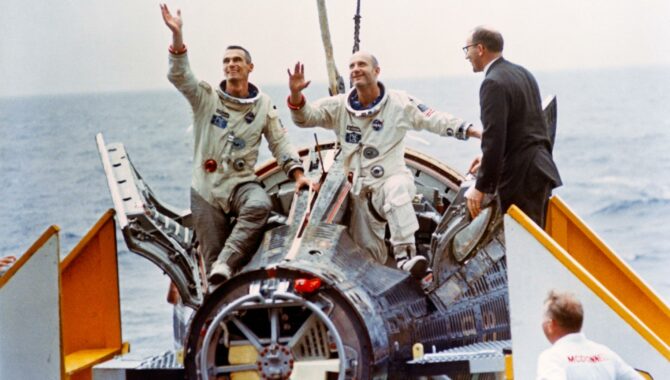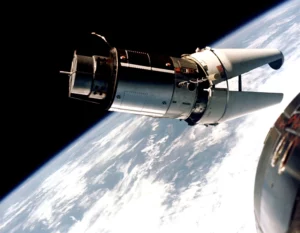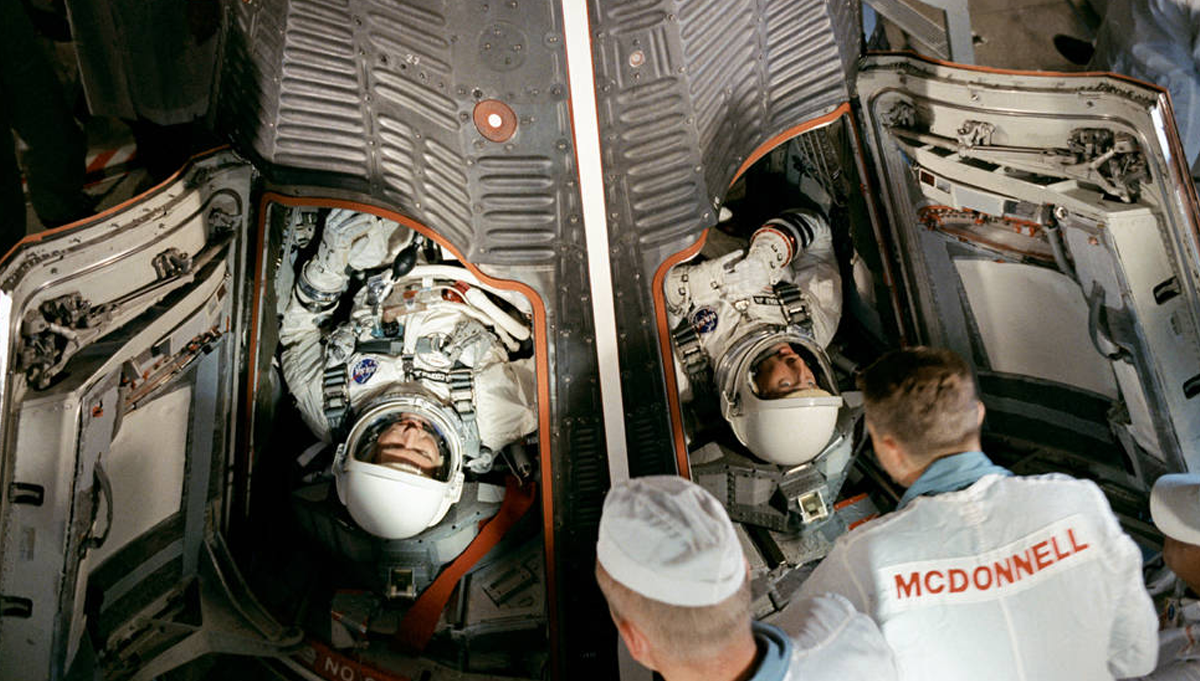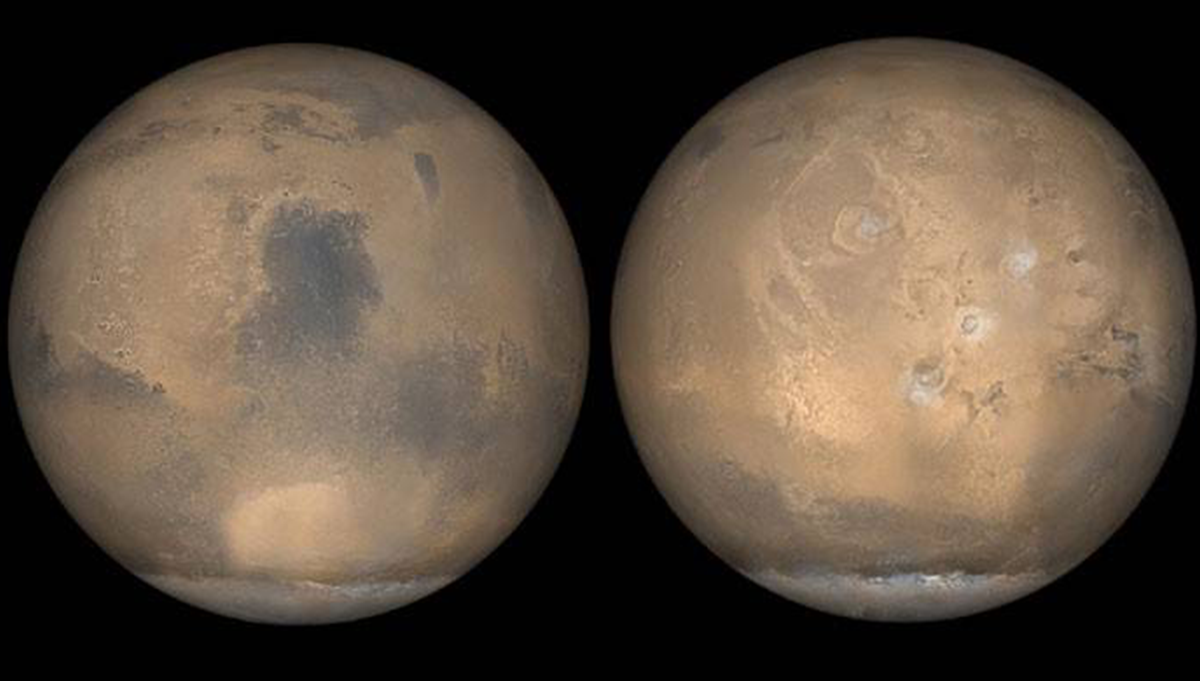
Astronauts Thomas Stafford (right) and Eugene Cernan wave to the crowd aboard the aircraft carrier USS Wasp as they emerge from their Gemini-IX-A capsule on June 6, 1966. John C. Stonesifer (far right), with the Manned Spacecraft Center’s Landing and Recovery Division, was onboard to greet the astronauts. Credit: NASA
Astronauts struggled with EVA unit and docking target during three-day mission overshadowed by pre-launch accident.
It was hazy and humid at Cape Kennedy’s Launch Complex 19 on June 3, 1966. NASA astronauts Thomas Stafford and Gene Cernan were strapped into the Gemini IX-A capsule, perched atop a Titan II booster, as Mission Control counted down. Stafford was about to become the first astronaut to fly a second Gemini mission—a distinction he would have gladly relinquished.
On February 28, 1966, Stafford and Cernan were flying “on the wing” behind their colleagues Elliot See and Charles “Charlie” Bassett. See and Bassett were the prime crew on what was then Gemini IX, piloting a T-38 jet trainer toward McDonnell Aircraft’s St. Louis facility. Engineers were putting the finishing touches on the mission’s capsule and the four were scheduled to train there for two weeks.
“I’d been to that airport many, many times—as backup on Gemini III and also prime for Gemini VI,” Stafford recalled in an oral history. “The forecast said 1,500 overcast, three miles’ visibility… but it wasn’t like that at all. The weather really got down.”
Flying close behind See’s T-38, Stafford saw thick clouds practically hanging down to the ground and snow flurries whipping through the sky. Both planes missed their approach. See banked sharply. Stafford followed, but ultimately had to pull away when he lost visual contact with the airplane in the rapidly deteriorating weather.
“I’m making a missed approach,” he called out. “I picked up the gear, added power, and dropped the flaps.” See struck McDonnell’s Building 101—where the Gemini IX capsule was being assembled—and the aircraft cartwheeled. See and Bassett were killed on impact.
The loss of an assigned crew just three months before their launch date was a shock to NASA. But with the race to the Moon in full swing, and key aspects of rendezvous and extravehicular activity left to master, backup crew Stafford and Cernan were named the prime crew.
“I’d had so much experience with the systems, being a back-up on Gemini III and the prime on Gemini VI,” Stafford recalled. “I told Cernan to concentrate on the extra-vehicular activities, besides learning the rendezvous, because I knew the systems.”

The Augmented Target Docking Adapter, or ATDA, as seen from the Gemini IXA spacecraft during one of their three rendezvous in Earth orbit. Failure of the docking adapter protective cover to fully separate on the ATDA prevented the docking of the two spacecraft. As a result, command pilot Tom Stafford described the ATDA as looking like an “angry alligator.”
Credit: NASA
Gemini IX was originally scheduled to launch on May 17, but NASA again experienced issues with the Gemini Agena Target Vehicle (GATV), which rode into space atop an Atlas rocket. “This time the Atlas got out over the ocean, did a bunch of loops, and Range Safety blew it up. So, we scrubbed out that one,” Stafford recalled. When the mission launched weeks later, it was renamed Gemini IX-A.
Having experienced problems with the GATV during Gemini VI and Gemini VIII, NASA developed the Augmented Target Docking Adapter (ATDA). The ATDA was a cylinder, 5 feet in diameter and about 10.9 feet long, with a mass of 1,750 pounds. The spacecraft repurposed the nose section of Gemini VI, as a docking mechanism powered by twenty-five-pound thrusters. When Stafford first saw it, he was concerned. It was pure black.
Realizing how difficult it would be to find it in the darkness of space, he spoke with Gemini program manager Charles W. Mathews. “ ‘You want me to try to rendezvous with that? I need some reflected light.’ ‘Well, the thermodynamics,’ Mathews replied. ‘[Nonsense],’ I said. ‘Put some silver tape on it,’ ” Stafford said.
As it turned out, the ATDA wasn’t remotely difficult to spot in space. The shroud that protected it during launch failed to separate.
“I remember coming up to it, and you could see the constellation Antares. There was a full moon out. We got up close, I could see this weird thing. I call it “The Angry Alligator.” It looked just like that. And it was slowly rotating,” Stafford recalled.
“To get an accurate picture, I got the Gemini spacecraft—it was a very maneuverable thing—rotate it, put the telephoto on my little camera in the window, and I just matched the velocities. We rotated. I got within about, oh, maybe a foot of it, like that, and just rotated around. You could see that [the shroud was] taped and tied,” Stafford said.
The mission included an EVA by Cernan and NASA considered sending him to the ATDA to assess the possibility of separating the shroud.
“I looked at it. I could see those sharp edges. We had never practiced that. I knew that they had those 300-pound springs there, didn’t know what else. So, I vetoed it right there,” Stafford recalled. “I said, ‘No way.’ ”
It was the second EVA by a NASA astronaut, and it highlighted the steep learning curve still ahead for working in the weightlessness of space.
“We depressurized. I’m flying the spacecraft using pulse mode, one millisecond pulse, going local horizontal. And Cernan goes out, and the first thing he does is place the rear-view mirror on the docking bar. He’s huffing and puffing. He’s torquing the hell out of this spacecraft, and I’m pulsing it back to be sure none of the thrusters fire on him,”
Stafford recalled.
Tasked with testing the Astronaut Maneuvering Unit (AMU)—a jet-propelled backpack intended to let astronauts fly untethered—Cernan went to the rear of the spacecraft and worked himself into the device, battling his own spacesuit. The AMU was a 165 lb. backpack, 32 in. high, 22 in. wide, and 19 in. deep. It was mounted on the rear of the Gemini capsule adapter section. It had a form-fitting seat, a nylon tether, and self-contained life-support. The EVA, which had seemed manageable in the simulations of the time, quickly became exhausting. Cernan’s visor soon fogged over, leaving him unable to see.
“And then we started to lose one way of two-way com,” Stafford recalled. “It was real scratchy. He could hear me. So, I worked out a binary system. I said, ‘Look, if you can hear me, make a noise for a yes. For a no, make two noises.’ So, I’d hear a “squawk,” and for “no,” I’d hear a “squawk, squawk.” So, I said, “Can you see?” I’d hear a “squawk, squawk.”
A concerned Stafford, out of contact with mission control, called Cernan back into the capsule, painstakingly guiding him through the movements along his 125-ft. tether. With both astronauts battling their pressurized spacesuits, Stafford reeled in the tether as Cernan moved along it, hand over hand. Stafford closed up the spacecraft and repressurized it.
“So, finally he got back in his seat, raised his visor, and his face was pink, like he’d been in a sauna. He says, ‘Help me get off my gloves, too.’ So, I helped him get his gloves off, and his hands were absolutely pink,” Stafford recalled. “So, I took the water gun and just hosed him down. You shouldn’t squirt water around in a spacecraft. Turns out he lost about ten and a half pounds in two hours and ten minutes outside. That was the third day.”
It was also the final day of the mission. Gemini IX-A splashed down in the Atlantic Ocean on June 6, 1966, coming within 700 meters of their target site and were by the crew of the USS Wasp. The splashdown happened closer to the recovery ship than any other crewed spacecraft. Cernan had lost a total of 13 pounds on the flight, most during the EVA.
To learn more about the race to the Moon, visit the APPEL Knowledge Services Apollo Era Resources page.









